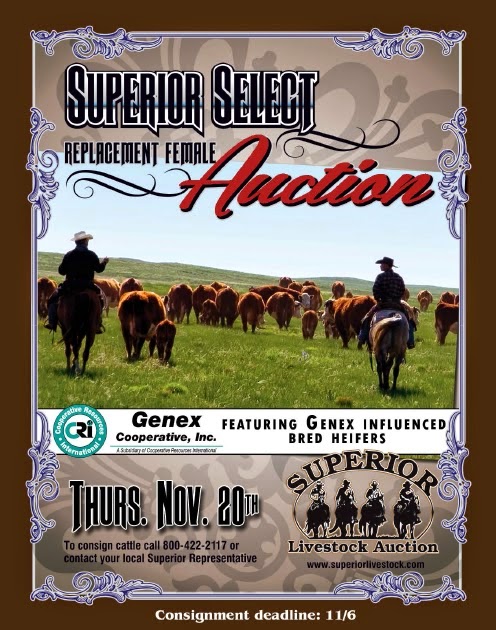It’s February, which means that bull sale season out west is
in full swing.
There is only one word to
describe the sales that have been held thus far, and that is HOT!
With the price of calves last fall, I don’t
think anyone has been surprised, that so far, bulls have been more expensive
this spring.
The average price of a
yearling bull is likely to be several hundred dollars more than it was last
year, if you have ever used the excuse that A.I. is to expensive, it may be time to revisit the economics.
At
Genex, we have a spreadsheet called A.I. vs the Bull. It allows producers to enter their inputs for
natural service and A.I. and determine what a pregnancy costs them. You could do the same thing on a piece of
scratch paper. It looks something like
this:
Natural Service Costs
Bull Purchase Price ≈ $4,398
(Average selling price, year-to-date September 2013, of bull sales reported
to the American Angus Association, November 2013, Angus Journal, page 206.)
Annual Bull Maintenance Cost (includes pasture, feed,
mineral, vaccinations, yearly breeding soundness exam, pour-on, damage to
property, interest, etc.) ≈ $900
Annual depreciation (assumes salvage value of $1700 and bull
has a useful life of 3 years) ≈ $900
Total bull cost/year (Annual Bull Maintenance Costs + Annual
Depreciation) ≈ $1,800
Let’s assume you expose this bull to 30 cows/year with a
weaning percent of 90%, so 27 calves will be born year. Cost per live calf is (Total bull
cost/year/number of live calves) ≈ $66.67
A.I. Costs
This scenario gives approximate A.I. costs for a group of
100 virgin heifers.
Synchronization Drug Costs (assume the 14-day Co-Synch +
CIDR® protocol, one injection of GnRH ≈ $1.80/injection, one injection of PGF2α
≈ $2.50/injection, one CIDR® ≈ $10) ≈ $14.30/female
Additional labor and arm service ≈ $10/female
Semen cost (high accuracy, calving ease Angus bull) ≈ $15.30/female
Total cost/female exposed ≈ $39.60
Total cost/A.I. calf (Assume 100 heifers bred, 65% A.I.
conception rate, weaning percent of 90%) ≈
$67.12
As you can see in this scenario, there is very little
difference between the cost/calf of a natural service sired calf vs. and A.I.
sired calf. What happens when you
consider your own input costs? We have not yet even considered the economics of things like the
potential for genetic gain from using a proven sire, more calves born earlier in
the calving season, and a more uniform calf crop.
One of the biggest advantages of A.I. is your opportunity to
capture genetics from top, proven bulls.
When you are buying a yearling bull to turn out with your heifers, you
hope that he is calving ease, and you use EPDs, the animals own performance
data, and physical appraisal to make your best guess to if he will be. But we’ve all heard horror stories about
someone who bought a young bull that they thought was supposed to be calving
ease and he did not turn out to be that way.
Another advantage of synchronization and fixed time A.I. is
the ability to have more calves born earlier in the calving season. At the
University of Missouri Thompson Farm, calf crop distribution was analyzed for
the first 46 days over 10 calving seasons.
There were three years of natural service breeding that included 526
calvings, two years of fixed-time A.I. with 397 calvings, and five years of
estrus detection and A.I. with 1,040 calvings.
At the respective day-16 of the calving season 38% of natural service
cows had calved, 54% of the estrus detection and A.I. cows had calved, and 62%
of the fixed time A.I. cows had calved.
By day 21 of the calving season those numbers were 51%, 59%, and 66%
respectively.
When you consider that a
calf will gain 2-3lbs/day and calf prices soaring, a calf born earlier in the
calving season is worth a lot more than any additional costs that may be
associated with A.I.
In addition to
heavier calves, a shortened calving season with large numbers of calves sired
by the same bull will result in a more uniform calf crop, which we all know is
more attractive to calf buyers.
If you have never considered A.I. before because you believe
that it is to expensive, now would be the perfect time to rethink your
position. Run the numbers, you may be
surprised that A.I. is right for you. If
you decide that you would like to try A.I. please contact your local Genex
Representative. They are equipped with
the knowledge and genetics to make your experience successful!
------------------------------------------------------------------------------------------------------------------------------------
Author,
Sarah Thorson, is our Beef Education Manager. Sarah grew up in Eastern
Montana on her family's ranch. She is a graduate of Montana State
University and has been a member of the Genex team since 2004. Sarah
works closely with the Genex Beef Marketing Staff, providing training to
the cooperative's nearly 200 Independent Contractors. She also
provides Artificial Insemination training for Genex members and
customers and reproductive consulting.



.JPG)




































.png)
.png)